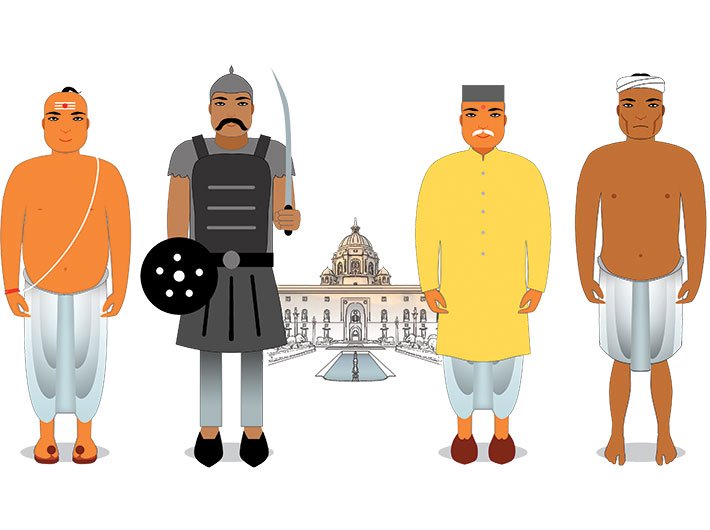In our system, the president is the head of the nation and the first citizen; his role and powers are almost akin to that of the queen of England or, say, kings in some other countries – ceremonial duties and safeguarding the constitution. Very often he is a public person with experience in politics, education (such as S Radhakrishnan) or maybe science (like APJ Abdul Kalam), who the ruling party can trust in a political or constitutional exigency.
The BJP got its chance to pick a presidential candidate in 2002 and Atal Bihari Vajpayee’s went for APJ Abdul Kalam, a missile scientist, as the 11th president of India. Now, in the BJP’s second chance, the Narendra Modi government’s choice has fallen on a well-qualified man, albeit with a difference – he has a caste too! At least that’s what the BJP is flaunting about its chosen one, Ram Nath Kovind, a former BJP spokesperson and the former Bihar governor. Its leaders would initially say that Kovind’s choice would leave the opposition stunned and divided. Now, with the combined opposition, led by the Congress, a party that all through its days in power had offered symbolism and tokenism to the demand of millions of poor and marginalised Indians for development, stymied this; it put up a candidate with a matching caste and flaunted it too. In the end, most Indians were wondering whether the script for this drama was borrowed from the detergent ad that said ‘Bhala iski kameez meri kameez se safed kaise!’
Seventy years after Indians were free from foreign rule and looked forward to enjoying equality, the demon of caste continues to haunt them; it does not spare even those who broke barriers and achieved success. Like Kovind, many who were born into castes considered low had broken free of the shackles of prejudice by taking some hard decisions like pursuing education and working hard to earn their place under the sun. Born in a middle-class family, Kovind’s life is a testimony to his determined effort to transcend caste at every stage. He even assumed a caste-neutral surname and didn’t offer a reason for it to his immediate family. Hindi scholars say ‘Kovind’ is not a listed word in the Hindi dictionary. They would like to believe that the would-be president had either picked ‘Govind’ meaning the Lord or ‘Kovid’ (meaning erudite or wise) which probably got distorted to ‘Kovind’ over the years. Or maybe he mixed the two (‘Kovid’ and ‘Govind’) to create a new surname and identity for himself and members of his family, who lived in a village near Kanpur. Kovind thus made conscious efforts to grow out of the identity linked to the accident of his birth. It’s clear that like most dalits would wish, Kovind wanted to move away from the caste-based milieu and grow as a human being with his throbbing human spirit.
In India, however, shedding a caste tag is impossible even in an age where we have become adept at shooting satellites into space and carrying out nuclear explosions. A person may shed it, but society will continue to judge him by the caste in which he was born. Generations continue to carry the burden of what probably began as division of labour in society, and later became the most inhuman and horrendous social institution of discrimination and oppression.
The intrinsic bond between a person and his caste was demonstrated when one of India’s most erudite presidents, KR Narayanan, whose achievements would give a complex to anyone believing in the so-called superiority of the ‘upper castes’, was addressed as India’s “untouchable president” by a leading French newspaper during his visit to Paris. Not intending to be derogatory, the French newspaper was, in fact, complimenting the president and the Indian system for the rise of an ‘untouchable.’ The French were surprised at India’s reaction, for they found it complicated to understand why the mention of the obvious (caste of the president) had made their guests jittery.
Even Mahatma Gandhi was not spared the caste tag recently, when BJP chief Amit Shah referred to him as “chatur baniya (clever or cunning baniya)” while he was trying to score a brownie point over Congress. The world’s most influential scientist may have said about Gandhi that “generations to come will scarce believe that such a one as this ever in flesh and blood walked upon this earth”, but for a fellow Indian who heads the world’s biggest political party, the apostle of ahimsa remains a baniya.
To be fair to the BJP, using the caste card is nothing new; every party, including the left, has used it for image building and bagging votes. But we expected that the BJP, which has recently registered a splendid victory over the caste-based parties in Uttar Pradesh, to tread a different path. Kovind was certainly not a high-profile person; the top position he held in the party was that of a spokesperson at a time when the going was tough for the BJP. Otherwise, he was in charge of the Schedule Caste cell of the BJP till an opportunity for him to get a gubernatorial position came up. Such cells – which exist in all parties – are again divisive and seek to accentuate the caste divide. Obviously, there are a number of high-profile and abitious leaders in the saffron brigade who wanted to beecome the president; but the party chose Kovind thinking it would be difficult for the united opposition to oppose a dalit.
Meira Kumar, the opposition’s nominee, has also been handpicked by Congress president Sonia Gandhi against Kovind for her caste. Kumar’s achievements are phenomenal; maybe it won’t be an exaggeration to say that her achievements are far superior to those of Kovind. As a former IFS officer, former Lok Sabha speaker and an absolutely poised politician, Kumar’s credentials are perfect for becoming the president. But here, she is named not for her qualities and qualifications but for the accident of her birth. Incidentally, Kumar is married to an upper caste person; yet she feels it important to retain her caste identity and the party also uses her as a dalit icon as and when required.
After Narayanan, Kovind will soon become India’s second ‘dalit’ president. Will it change the condition of one-sixth of India’s population that still suffers caste slurs and discriminations at social and economic levels. Narayanan’s being in the Rashtarapati Bhawan didn’t make a difference in their lives; Kovind’s will be no different. The education system will continue to be infested with social biases against ‘quota’ students like Rohit Vemula, leaving them bitter and regretful of their existence; the conviction of those involved in inflicting excesses on dalits will remain abysmally low. Dalits would continue to live in ghettos while leaders will be celebrating the rise of a dalit in Rashtrapati Bhawan.
aasha@governancenow.com
(The article appears in the July 1-15, 2017 issue of Governance Now)

